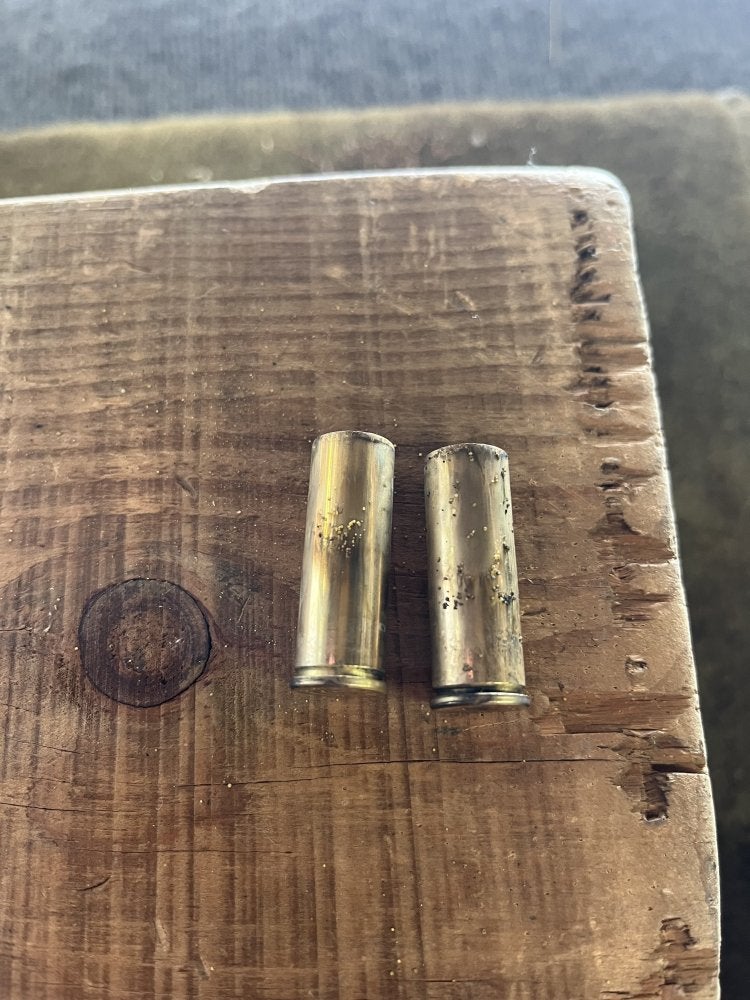Hello folks,
I’ve recently purchased a SRH Alaskan in 454 Casull and have begun reloading for this caliber recently. I’ve been reloading for about 1 year and have reloaded only 357 and 44 Magnum up till now.
My goal is to find a 454 Casull load that is about as much pressure as a 44 Magnum using lead coated bullets to keep the reloading costs down. I don't want to reload 45 Colt since I already have the 454 brass.
For my first 454 reloads, I used the 255 grains Missouri Bullet Company 45 Elmer K Hi-Tek bullets, Accurate #9 powder, Federal Small Rifle primer (#205), and 454 Starline brass.
Per the Lyman 51st edition manual, the starting load for 454 Casull using AA9 powder with a 255 grain lead bullet is 25.7 grains of powder. I’ve tried and shot the first 12 rounds earlier this week.
I noticed that the first 454 Casull rounds I fired, there was a little unburned powder on the cylinder and a barrel of my SRH Alaskan. I’ve also noticed a slightly compressed primer, which could be a sign of overpressure since I’m seating the MBC bullets a little deeper than the 1.760 OAL listed in the Lyman Manual which uses a different 255 lead grain bullet. I’m crimping my rounds at the crimping groove for the MBL bullet and the OAL for my reloads is 1.704 OAL.
Even though the starting load in the Lyman manual lists 25.7 grains, on the Freedom Arms 454 Reloading PDF, the suggested starting loads for 250 and 260 bullets are 23.5 and 22.5 grains respectively. I’m thinking of trying 23.5 grains and doing a ladder test up to 25 grains of AA9 to see if I don’t get any overpressure signs.
I’d like to ask the more knowledgeable forum members is that sounds like a good next step.
Do any of you reload 454 Casull with lead bullets and AA9 powder?
Thank you,
SPEED-SIX
I’ve recently purchased a SRH Alaskan in 454 Casull and have begun reloading for this caliber recently. I’ve been reloading for about 1 year and have reloaded only 357 and 44 Magnum up till now.
My goal is to find a 454 Casull load that is about as much pressure as a 44 Magnum using lead coated bullets to keep the reloading costs down. I don't want to reload 45 Colt since I already have the 454 brass.
For my first 454 reloads, I used the 255 grains Missouri Bullet Company 45 Elmer K Hi-Tek bullets, Accurate #9 powder, Federal Small Rifle primer (#205), and 454 Starline brass.
Per the Lyman 51st edition manual, the starting load for 454 Casull using AA9 powder with a 255 grain lead bullet is 25.7 grains of powder. I’ve tried and shot the first 12 rounds earlier this week.
I noticed that the first 454 Casull rounds I fired, there was a little unburned powder on the cylinder and a barrel of my SRH Alaskan. I’ve also noticed a slightly compressed primer, which could be a sign of overpressure since I’m seating the MBC bullets a little deeper than the 1.760 OAL listed in the Lyman Manual which uses a different 255 lead grain bullet. I’m crimping my rounds at the crimping groove for the MBL bullet and the OAL for my reloads is 1.704 OAL.
Even though the starting load in the Lyman manual lists 25.7 grains, on the Freedom Arms 454 Reloading PDF, the suggested starting loads for 250 and 260 bullets are 23.5 and 22.5 grains respectively. I’m thinking of trying 23.5 grains and doing a ladder test up to 25 grains of AA9 to see if I don’t get any overpressure signs.
I’d like to ask the more knowledgeable forum members is that sounds like a good next step.
Do any of you reload 454 Casull with lead bullets and AA9 powder?
Thank you,
SPEED-SIX







